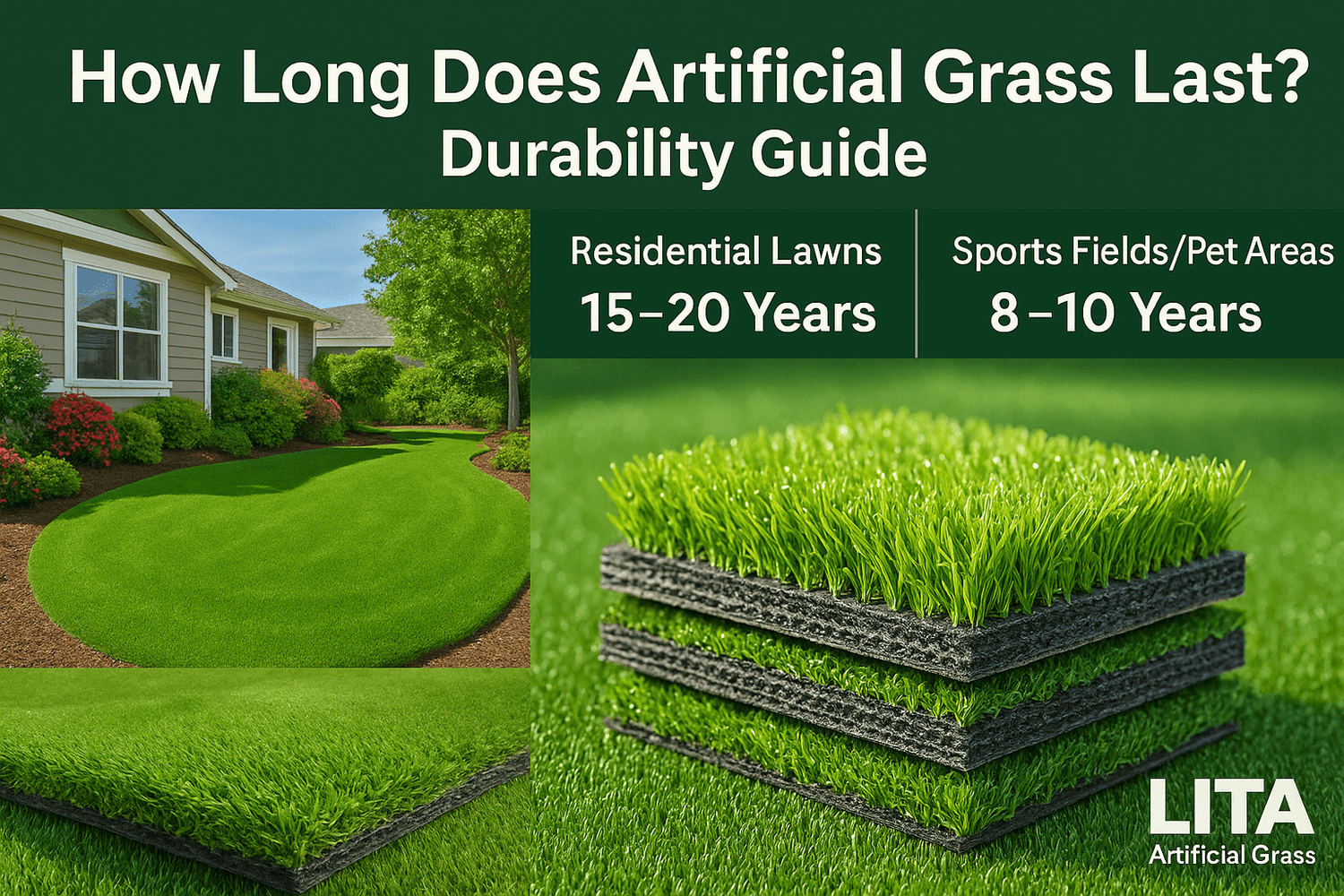Artificial grass is a type of fake grass made from plastic. It looks like natural grass but doesn’t need mowing or watering. People use it in yards, schools, parks, pet areas, and even sporting arenas. It’s called artificial turf or synthetic turf too.
This kind of lawn is popular now because it saves time and money. It also helps with water conservation since it doesn’t need an irrigation system. Many homes and businesses in sunny places like San Diego use artificial grass to keep their yards green all year.
But one big question people ask is: How long does artificial grass last? The artificial grass lifespan depends on how it's made, how it’s used, and how well you take care of it.
What Is the Average Artificial Grass Lifespan?
Most synthetic grass lawns last 10 to 20 years. Some may wear out sooner, while others last longer with good care. The life expectancy also depends on how much foot traffic it gets.
If you use your lawn just for looks or light use, it can last up to 20 years. But in places with heavy use—like a dog run or sports field—it might wear out faster. Constant running, playing, or pet waste can cause more wear and tear.
Commercial and sports applications usually need replacement after 8 to 10 years. In comparison, a home synthetic lawn can easily last longer.
The Synthetic Turf Council says that most products come with a product warranty of 8 to 15 years. That gives you an idea of how long turf makers expect their grass to last. But with light maintenance like debris removal and fixing small problems, it can stay strong for many more years.
Key Factors That Impact Artificial Grass Lifespan
Artificial grass can last many years, but that depends on several things. Some lawns stay strong for 15–20 years. Others may wear out sooner. Let’s look at the main factors that affect how long your synthetic grass will last.
1. Quality of Materials
The type of material used to make artificial turf matters a lot. Most fake grass is made from nylon, polyethylene, or polypropylene.
- Nylon is the toughest. It holds its shape well and doesn’t flatten easily. It is best for high-use areas like sports fields or dog run spaces. But nylon can feel rough, and it costs more.
- Polyethylene is softer and looks more like real natural grass. It is great for home lawns and is still strong enough for regular use. This is the most popular option for synthetic lawns.
- Polypropylene is the cheapest, but it wears out the fastest. It’s not a good choice for areas with a lot of foot traffic or pet areas.
Besides the plastic type, you should also check if the turf has UV protection. Sunlight can cause damage over time. Turf made with UV-resistant materials or treated with UV inhibitors will fade less and last longer.
These special UV-resistant additives help protect the blades from cracking or losing color in the sun. Without this, UV damage and heat buildup will ruin your lawn faster, especially in sunny places like San Diego or under the strong Arizona sun.
2. Installation Quality
Even the best turf can wear out early if it’s not installed right. The installation process plays a huge role in the artificial grass lifespan.
If the ground is not prepared well, the grass may shift or wrinkle. A proper stone base is needed to keep the surface even and strong. If seams are not sealed well, they can come apart, making the grass look messy and unsafe.
A poor installation can also lead to drainage problems. Water may collect under the turf if drainage systems are not built correctly. This can cause mould, odours, or even damage the turf backing.
That’s why it’s best to hire landscape professionals or a greenscape installer. They know how to lay the turf properly, add the right infill materials, and make sure everything drains well. While installation costs may be higher, proper setup means fewer repairs later and a longer-lasting lawn.
3. Climate and Sun Exposure
Weather and sunlight also affect how long synthetic turf will last. If you live in a hot, sunny place like San Diego or Texas, your turf may face more wear and tear.
Strong sun can break down weak plastics. This leads to fading, cracking, and loss of blade shape. That’s why UV-stabilized materials are important. They protect the grass from too much heat and light.
Also, rain and temperature changes can impact the turf. In wet places, water needs to pass through the grass easily. That’s where good drainage systems help. Without them, water may pool and ruin the turf from below.
To protect your lawn, choose turf that is made for your local climate. Ask your installer about UV resistance, drainage, and how the product handles heat. Good turf can handle different weather, but you need the right kind for your area.
4. Usage Intensity
How often you use your turf matters too. If your lawn sees a lot of foot traffic, it will wear out faster than one that’s mostly for show.
- Heavy use areas include sports applications, schools, and dog run areas. These need stronger turf and more care.
- At home, pet waste, children playing, and daily walking can also shorten the life expectancy of your turf.
For active homes, choose turf with thicker blades, stronger backing, and high shock absorbency. This will help it bounce back after use and stay looking fresh.
If your turf gets used a lot, it may also need more light maintenance. Areas with more activity will flatten or collect more dirt, which should be cleaned regularly.
So, think about how your family, pets, or customers will use the turf. High-traffic lawns need higher-quality grass.
5. Maintenance and Upkeep
People often say artificial turf lawns are “no-maintenance,” but that’s not fully true. They are low-maintenance, not zero.
To keep your turf lasting longer, follow some simple maintenance techniques:
- Rake or brush the blades often. This helps keep them upright and spreads out the turf infill. Fluffing prevents the grass from getting flat or stiff.
- Hose down your turf. This removes dust, pollen, and dirt. It’s important in dry areas where there’s no rain to help with cleaning.
- Clean pet messes quickly. Use water and mild soap to wash away pet waste. Some people also use odor-reducing infills to help with odor control in pet areas.
- Remove leaves or trash. Basic debris removal keeps your lawn clean and avoids damage over time.
- Fix small problems fast. If you see loose seams or ripped spots, get them repaired right away. Waiting too long can make it worse.
Comparing Artificial Grass Lifespan by Use Case
The lifespan of synthetic turf changes depending on where and how it’s used. Here’s a quick guide:
|
Application |
Expected Lifespan |
|
Residential Lawns |
15–20 years |
|
Sports Fields |
8–10 years |
|
Pet Turf Areas |
8–12 years |
|
Commercial Landscaping |
10–15 years |
|
Rooftop/Urban Turf |
10–15 years |
How to Know It’s Time to Replace Artificial Grass
Even though artificial turf is made to last, nothing lasts forever. Over time, you might notice signs that it’s time for a change.
Here are a few things to look for:
- If the grass blades stay flat even after brushing or raking, the turf may be too worn out.
- Fading or yellow spots that don’t go away could mean the turf has suffered UV damage.
- If some areas feel lumpy or saggy, the turf backing or infill materials may be breaking down.
- These can become tripping hazards and are often hard to fix once they appear.
- If your turf has a strong smell that doesn’t go away even after cleaning, especially in pet areas, it may be time for replacement.
Is Artificial Grass Worth It for Long-Term Durability?
Many people ask if artificial turf is worth the money. The answer is yes, especially when you choose a reliable brand like LITA Grass, which is built to last and easy to care for.
At first, turf can be expensive to install. But it pays off over time. You don’t need to water, mow, or use fertilisers like you do with natural grass. That means lower bills, fewer tools, and more free time.
Most people get their return on investment (ROI) in 3 to 5 years. After that, all the savings go right into your pocket. Plus, your lawn stays green all year, even during droughts or water bans.
You’ll also use less water, which is great for areas with water restrictions or hot, dry weather. That helps with water conservation and lowers your water usage.
Conclusion
Artificial grass lasts a long time with very little upkeep. Thanks to strong materials, UV protection, and easy maintenance, it stays green and clean for years. Whether you have kids, pets, or just want to save time and money, turf is a smart long-term choice. High-quality brands like LITA Grass make it even better with soft, durable options for any yard.
Ready to upgrade your lawn? Explore LITA Grass for a turf that’s built to last.



Leave a comment
This site is protected by hCaptcha and the hCaptcha Privacy Policy and Terms of Service apply.